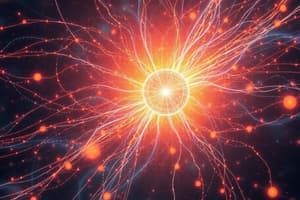Podcast
Questions and Answers
What is the term used to describe the stagnant layer of thickness at the electrode surface?
What is the term used to describe the stagnant layer of thickness at the electrode surface?
- Nernst layer
- Stagnation layer
- Concentration gradient layer
- Diffusion layer (correct)
In the context of the text, what is the mass-transfer coefficient represented by the symbol mO?
In the context of the text, what is the mass-transfer coefficient represented by the symbol mO?
- Diffusion coefficient
- Concentration gradient
- Mass-transfer coefficient (correct)
- Total mass
Which condition leads to the largest rate of mass transfer of O according to the text?
Which condition leads to the largest rate of mass transfer of O according to the text?
- CO* = 0
- CO(x=0) = 0 (correct)
- CO = 0
- CO(x=0) = CO*
When the reduction current is considered positive, what relationship exists between CO* and CO(x=0)?
When the reduction current is considered positive, what relationship exists between CO* and CO(x=0)?
What happens when CR(x=0) > CR* in the context of electrode processes?
What happens when CR(x=0) > CR* in the context of electrode processes?
What is the maximum possible rate at which an electrode process can occur under a given set of mass-transfer conditions known as?
What is the maximum possible rate at which an electrode process can occur under a given set of mass-transfer conditions known as?
What is the role of an inert electrolyte in reducing mass transfer in electrochemical systems?
What is the role of an inert electrolyte in reducing mass transfer in electrochemical systems?
How can convection be minimized in an electrochemical cell?
How can convection be minimized in an electrochemical cell?
In the Nernst-Planck equation, what does Ji represent?
In the Nernst-Planck equation, what does Ji represent?
What is the function of ϕ(x) in the Nernst-Planck equation?
What is the function of ϕ(x) in the Nernst-Planck equation?
How does a rigorous solution become challenging in electrochemical systems?
How does a rigorous solution become challenging in electrochemical systems?
In the context of electrode processes, what is the relationship between the concentration of species O at the electrode surface and the current?
In the context of electrode processes, what is the relationship between the concentration of species O at the electrode surface and the current?
For a nernstian reaction, when are the concentrations of O and R at the electrode surface assumed to be at equilibrium with the electrode potential?
For a nernstian reaction, when are the concentrations of O and R at the electrode surface assumed to be at equilibrium with the electrode potential?
What is the slope of a plot of log[(il-i)/i] vs. E for a system that follows the given equation?
What is the slope of a plot of log[(il-i)/i] vs. E for a system that follows the given equation?
What is the name given to a process where the concentrations at the electrode surface are at equilibrium with the electrode potential?
What is the name given to a process where the concentrations at the electrode surface are at equilibrium with the electrode potential?
What does the slope of the i-E plot indicate for a system conforming to the provided equation?
What does the slope of the i-E plot indicate for a system conforming to the provided equation?
When i=il/2, what is the relationship between the electrode potential and E1/2?
When i=il/2, what is the relationship between the electrode potential and E1/2?
Flashcards are hidden until you start studying




